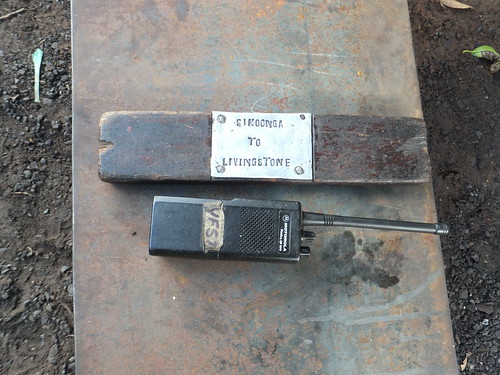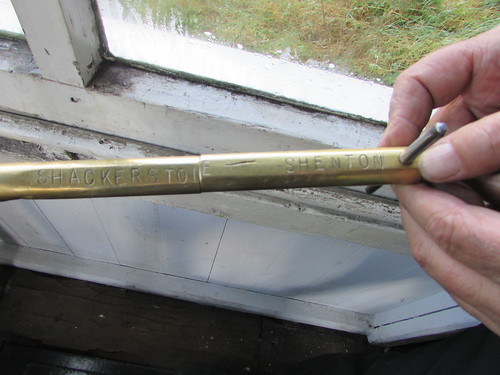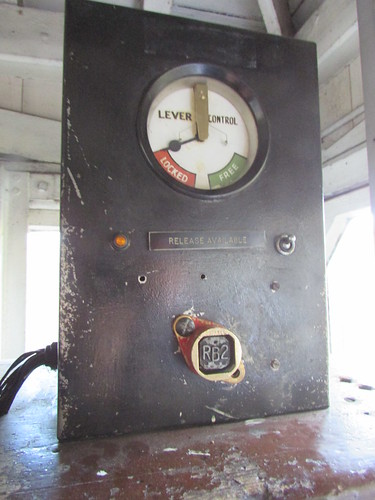Train Staff Working
But single-line railways needed a different approach from the start as there was not only the danger of one train catching up with another but the possibility of trains travelling in opposite directions meeting head-on. The Americans have an evocative phrase for this event - 'cornfield meet'. In the U.K. the system of a 'Train Staff' was adopted. This was often a rounded length of wood (hence the name 'staff'). There was only one Train Staff for each single line section, marked with the section of line to which it applied. Before entering a single line, the driver took possession of the unique Train Staff and was thus assured that no other train was occupying the section. On clearing the single line, the driver would surrender the staff, allowing another train to enter the single line. Provided drivers were in possession of the the Train Staff when on the Single Line, this simple system was safe.
To increase the capacity of the line, a long single line was often divided into separate sections by intermediate stations provided with passing loops. There was only one Train Staff for each single line section between passing loops, marked with the names of the two stations between which it applied. Again, provided the footplate crew made certain they were carrying the correct staff for the section, the system remained safe. Train Staffs could be distinctively painted or shaped to assist the driver and fireman in identifying the correct staff but enginemen were also expected to read the names of the stations marked on the staff as a cross check. When I was a trainee fireman in preservation, I was taught to collect the Train Staff from the Signalman (or person in charge), check the details, shout "Correct Staff!" then display it to my Driver so that he could independently satisfy himself that we had proper authority to enter the single line section.

Simoonga - Livingstone single line staff (and two-way train crew radio), Victoria Falls Steam Railway, Zambia.
A bigger problem with this simple system was its inflexibility. If trains alternated in direction on the single line, the first train carried the staff from station A to station B, the second train, in the opposite direction, returned it from station B to station A. But there was no way for a second train from A to B to follow the first whilst the Staff remained at station B. There are tales of junior porters having to carry the Staff to the opposite end of the single line by bicycle in exceptional circumstances.
Train Staff and Ticket Working
Train Staff and Ticket Working seeks to address the inflexibility of ordinary Train Staff Working. The signalman or Person in Charge at station A must be in possession of the Train Staff before allowing a train into the single line section.
If a second train will run in the opposite direction, the Train Staff is actually CARRIED by the driver of the first train so as to be available for the second train on arrival at station B.
If a second train will follow the first in the same direction, the driver of the first train must be SHOWN the Staff. Seeing the Staff gives assurance that another train has not entered the opposite end of the section. The signalman also issues a numbered paper Ticket to the driver, identifying the specific train and giving authority to pass through the single line. When the train arrives at station B, the ticket is surrendered to the Signalman or Person in Charge there who cancels the Ticket. Because the Train Staff is still at station A, a second train may follow, this time with the driver CARRYING the Staff (unless a further Ticket is issued because of a third train in the same direction).
With Staff and Ticket working, telephone communication between the Signalmen or Persons in Charge at either end of the single line is essential because a further Ticket must not be issued until any previous Ticket had been correctly received and cancelled. Before allowing a train onto the single line, the Signalmen or Persons in Charge at both ends must agree upon the direction of the NEXT train required to pass over the single line. Whether a driver receives the Staff or is shown the Staff and receives a Ticket depends upon the direction of the NEXT train through the section. If the next working is in the opposite direction, the Staff is carried to the other end so it can be given or shown to that train. If the next working is in the same direction, the driver is shown the Staff (so that it can be shown to or carried by the following train) and CARRIES the Ticket. Tickets are valid for one specific train and, after a single use, are cancelled by the Signalman or Person in Charge receiving the used ticket.
Electric Token Working
Single-line control eventually benefited from the use of electrical interlocking from one end of a single line section to the other, allowing multiple single line tokens to be housed in machines at either end of each single line but ensuring that only one token could be released at a time and that it had to be returned (to either machine) before a further token could be extracted (from either machine). This arrangement allows 'unbalanced' working of trains until either machine runs out of stored tokens. Numerous designs are in use in various parts of the world, including:-
Electric Key Token ('Lollipop' token).This very simple explanation clearly needs expanding in the future.
Tablet (round, metal disk token).
Ball token (Neale's pattern as widely used in Thailand)
Interlinking with Signals
A feature of British signalling practice where a train staff is used is an electrical interlock to ensure that the appropriate staff is present in the signal box before the signal admitting a train to the single line (the 'section signal') can be 'cleared'. For instance, this safeguard is provided at Shackerstone on the Battlefield Line.

The Single Line Token at Shackerstone.

The Single Line Token, showing the incorporated 'Castell Key'.

The Release equipment in Shackerstone signal box for the 'Section Signal'.

Token inserted into Release equipment.

Token inserted into Release Control and turned. Yellow Lamp lit indicates the release is available to allow the 'section signal' to be 'cleared'.
Pilotman Working
If a train staff is lost or damaged or electric token equipment fails, subject to suitable safeguards, trains may continue to run using a 'human agent' as a Pilotman. He identifies himself to all staff by wearing a special armband marked 'PILOTMAN' (or, in exceptional circumstances, an armband made from a red flag).
Related articles on other sites
Token (railway signalling) Wikipedia.
Indian Railways single line instruments The Signal Box.
